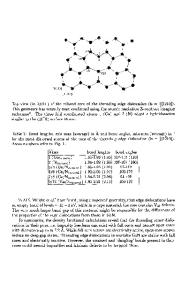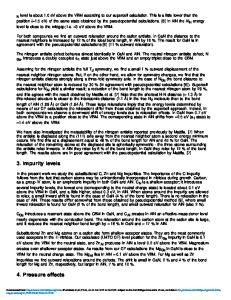Theoretical Study of Hydrogen in Cubic GaN
- PDF / 406,187 Bytes
- 6 Pages / 414.72 x 648 pts Page_size
- 51 Downloads / 326 Views
ABSTRACT Preliminary results of theoretical studies of hydrogen and hydrogen-related defects in cubic GaN are reported. Our calculations contrast with those of other authors in that the host crystal is represented by molecular clusters rather than periodic supercells, and that they are obtained using an all-electron methodology rather than the single effectiveparticle approach of density-functional theory. Our results confirm some predictions of other authors but conflict with others.
INTRODUCTION All GaN crystals contain large concentrations of defects and impurities, as shown by 2 the n-type character of as-grown samples and the yellow luminescence they exhibit."' The former implies that native shallow donors are present, and the latter that deep levels are in the gap. FTIR spectra and SIMS profiles show the presence of defect centers containing 7 H, 0, Si, C, and others impurities, in concentrations ranging from 101 to as much as 1021 cm- 3 . Hydrogen or deuterium are also easily introduced in high concentrations by exposure to an ECR plasma, proton implantation, etching with H-containing chemicals, or even by boiling in water.2-6 Hydrogen is one of the most common and probably the most versatile impurity in all 0 semiconductors.7-1 In addition to any surface reactions, H diffuses through the bulk, seeks out stretched or dangling bonds at impurities and defects, where it forms covalent bonds. This results in geometrical changes and shifts the energy levels of the original defect center. Thus, hydrogenation profoundly affects the optical and electrical properties of the material. The optical changes are new or different IR and Raman local modes and/or new photoluminescence lines. The electrical changes may be passivation (a level moves from the gap to a band), activation (a level moves from a band to the gap), or 'level shifting' (a level shifts within the gap, e.g. a shallow level becomes deep). The latter situation may be common in wide bandgap materials because energy levels may have to shift a lot to disappear from the gap. These reactions are reversible. Annealing (usually a few hundred degrees Celsius) breaks the bond involving H and restores the sample to its prehydrogenation condition. In some cases, the injection of minority charge carriers greatly enhances the reactivation reactions. Note that the temperatures required to reactivate H-passivated centers are lower than those required to force H out of the material. In GaN, it is believed that H is abundant as an isolated interstitial and in various complexes. In p-type GaN, the data suggest that H passivates (or compensates) the shallow 3 5 6 11 2 Mg acceptor, and has a shallow donor level in the gap. ' ' ' "1 The formation of {H,Mg} pairs is consistent with the observation that the amount of incorporated H increases linearly 3 with the concentration of Mg.' Further, the temperature dependence of the processes is 613 Mat. Res. Soc. Symp. Proc. Vol. 423 01996 Materials Research Society
3 5 similar to that for H-acceptor pairs in other semiconductors. '
Data Loading...











